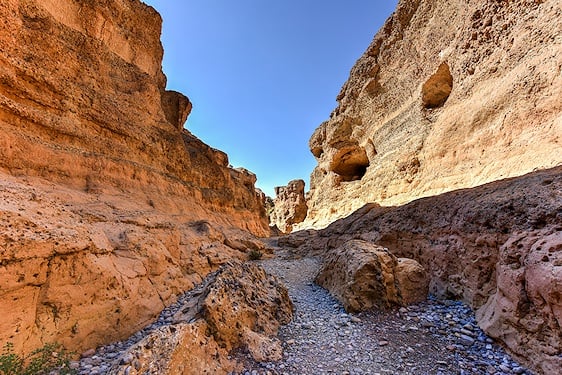Sossusvlei Travel and Vacations
Help Me Plan- Home
- >
- African Travel
- >
- Namibia
- >
- Sossusvlei
Sossusvlei Destination Guide
Sossusvlei delivers a surreal desert experience: towering red dunes, stark white pans, and skies ablaze with stars. Travelers come for the scenery, not dense wildlife, and leave with lifelong images and calm. Access is straightforward by road or charter, with comfortable lodges nearby and activities timed for sunrise and late afternoon.
Getting to Sossusvlei
By Air: There are no commercial flights to this remote outpost - only scheduled and private charter flights between Sossusvlei and main tourism hubs like Windhoek, Swakopmund, and Etosha. Remember that charter flights are costly and may seriously augment your traveling costs. Strict luggage restrictions also apply.
By Road: From Swakopmund and Windhoek, the overland trip to Sossusvlei is around 5 to 6 hours. The route is typically tackled in a hardy 4x4 vehicle as it passes through harsh desert landscapes. All vehicles are air-conditioned with comfortable interiors - your comfort and safety while traveling are paramount.
Weather & Best Time To Visit
Sossusvlei is not as dramatically affected by the seasons as other parts of Namibia, which means that it is an excellent year-round destination. However, if one had to choose an ideal time to visit, it would be during the interim seasons: autumn, from mid-March to mid-May, and spring, from mid-August to mid-October. Temperatures are more moderate during these periods, with average maximums of 30°C - 33°C (86°F - 91°F) and minimums in the range of 10°C - 15°C (50°F - 59°F).
Winter (mid-May to mid-August) offers optimal daytime temperatures for activities, as maximums hover around a pleasant 27°C (81°F). Minimums, however, occasionally dip to the freezing point. The east wind makes an occasional pest of itself in the winter months, blasting an unseasonably hot, sandy wind across the desert en route to the coast. Luckily these nasty spells are scanty and only last a few days.
Summer can be a scorcher, particularly in the months before the rains have fallen (October & November). The mercury can push past 40°C (104°F) during this period. The inland rains cool down the interior a bit from December to February.
Medical Considerations
Sossusvlei is not located in a malaria-risk area. Therefore, you should only concern yourself with anti-malaria prophylactics if you are venturing further north. Ensure that your routine vaccinations are up to date, and be cautious and attentive when enjoying moderate-risk activities like quad biking.
Health & Safety
Sossusvlei is in the desert. Ensure that you stay hydrated (bottled mineral water is readily available at all lodges and accommodations), wear a proper hat when venturing out, and reapply sunblock as necessary. Petty crime is low to non-existent in this remote outpost. Animals are scarcely seen but prevalent - avoid feeding wild animals or approaching them.
Top Travel Attractions Near Sossusvlei
Sossusvlei is located in the largest conservation area in Africa, the Namib-Naukluft Park. Though very arid, the region is blessed with plant and animal species that have adapted to harsh conditions, where solitude, magnificent scenery, and a night sky that seems close enough to touch are among the highlights travelers experience.
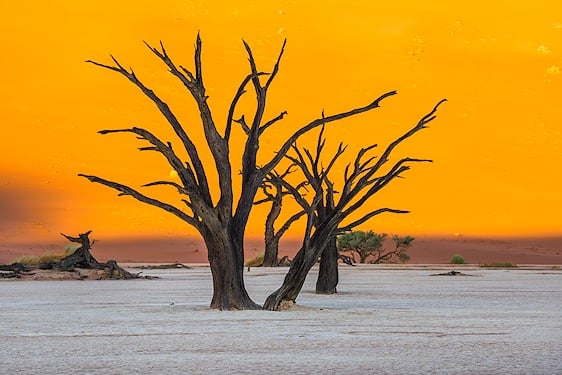
Deadvlei
Located a stone's throw from Sossusvlei, Deadvlei is characterized by the stark contrast between the surrounding red dunes, the dark dead camel thorn tree, and the white clay floor on which they stand. It is a favorite location for photographers of all skill levels.
Sesriem Canyon is a unique geological feature shaped by the Tsauchab River, located approximately 4.5 km from the park entrance at Sesriem. Early Afrikaans travelers named it because six leather straps had to be bound together to lower a bucket into the river below.
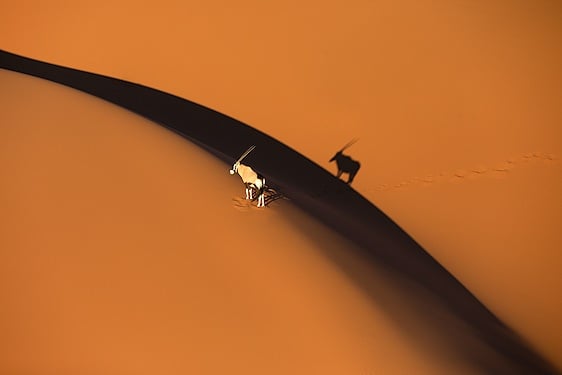
Dune 45
Dune 45 is a classic climbing and photographic spot named for its position 45 km from the Sesriem gate. Its summit offers far-reaching views across the dune sea.
Sossusvlei Vacation Options & Travel Tips
Experience isolation and tranquility in alien-like landscapes with distinct geographical features and vast open desert-scapes, surrounded by colossal red sand dunes.

Tours, Safaris & Honeymoons
Browse our thoughtfully crafted safari tours.

Tailor-Made Vacation Packages
All our tours and safaris can be customized.

Travel Tips & Advice
Important information about visiting Southern Africa.
Recommended Lodges
Sossusvlei offers a variety of accommodation options for such a desolate desert environment. These are our favorites.
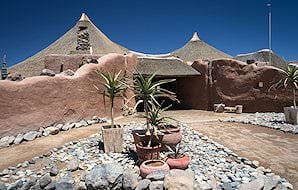
Kulala Desert Lodge
Kulala Desert Lodge offers some of the finest accommodations available at Sossusvlei. The reserve on which it is located has a private entry gate to Namib-Naukluft National Park.
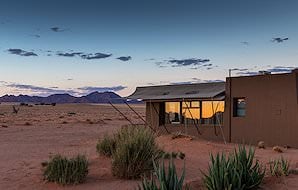
Sossusvlei Lodge accommodates guests in forty-four luxury units. All units are air-conditioned and offer splendid views of the desert and the magnificent night sky.
Sossusvlei Travel Overview
In the central Namib Desert lies a clay pan within the Namib-Naukluft National Park called Sossusvlei. “Vlei” in Afrikaans means a shallow depression filled with water. Sossusvlei is a mud pan created by a river that flows through the Namib every 5 to 10 years.
Remarkable Photographer's Paradise
Namibia abounds in unique photographic opportunities, from the white pans in Etosha located in the north to the Fish River Canyon in the south, yet few regions offer the intriguing landscape of Sossusvlei.
Sossusvlei presents numerous beautiful and haunting scenes at different times of the day, such as the eerie dead trees on the white pans surrounded by giant red dunes, or the clear starry sky with a full moon casting a dim yet peaceful light over the desert landscape. Visitors can also climb Dune 45 for panoramas or consider a balloon trip for a bird’s-eye view.
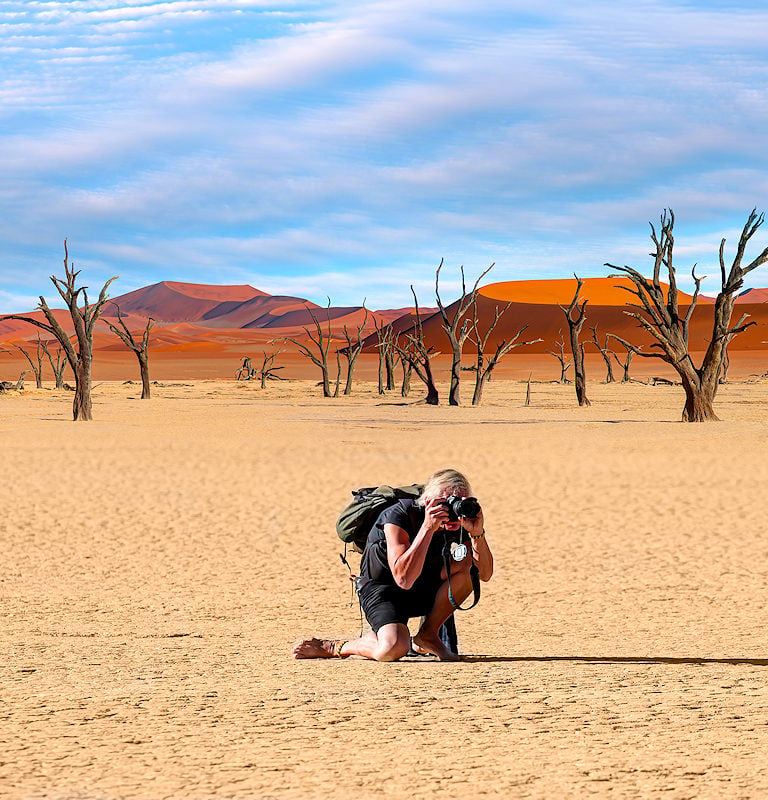
Foods to try when visiting Sossusvlei
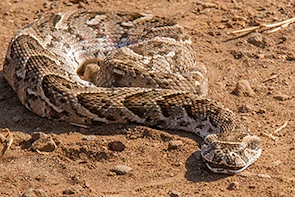
Pofadder
A dish that might not be for everyone – though the locals love it – has the Afrikaans name of the venomous puff adder snake. The fat intestine of a gemsbok is stuffed with ground-up liver, onion, and green pepper and then slow-roasted over a fire.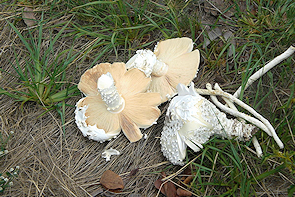
Omajova
Omajova is a wild, edible Namibian mushroom that grows on termite mounds after rain. The unconventional fungus is delicious served in flavorful soups or sautéed in butter with salt and garlic.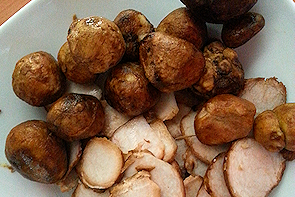
Nabas
Although the "Kalahari truffle" is native to the country's southwestern corner, it is worth ordering where it is available. A distant cousin of the European black and white truffle, it is thinly sliced and served in salad, soups, and sauces.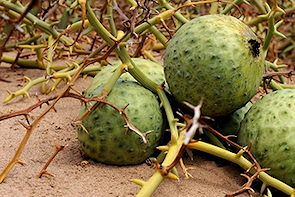
Nara Melon
Nara is a nutritious fruit popular with the San for its multipurpose properties. It yields a sweet, thirst-quenching liquid, while the pulp can be made into a cake. It can also be baked into a long-lasting breadstuff, while its roots have medicinal value.Sossusvlei FAQ
Yes. This is the preferred method for travelers on a budget, or those who are fearful of light aircraft. It may be a lengthy trip (around five hours in duration), but the scenery is stunning, and it offers the perfect opportunity for a catnap following your long journey to Southern Africa.
Sossusvlei is not a destination that you visit for the wildlife - it is a destination that you visit for its awe-inspiring scenery. If you are lucky, you may encounter brown hyena, and you are very likely to see gemsbok, ostrich, and springbok during your visit. If you are after serious game viewing, however, Etosha National Park offers the finest safari experience in the country.
The tiny settlement of Sesriem is the closest "town". It basically consists of a filling station and a handful of general stores for basic purchases.
Your accommodation will always have bottled mineral water readily available for you.
At 325 meters, Big Daddy is the highest dune in the Sossusvlei area.
Deadvlei and Sesriem Canyon definitely warrant visits when you're in the Sossusvlei area.
You are pretty much off the grid when visiting Sossusvlei. Enjoy your break from the 21st century's constant connectivity and instead connect to nature.
Mammals & Birdlife
Fauna in the Sossusvlei area is relatively rich. It mainly comprises small animals that can survive with little water, including several arthropod, small reptile, and small mammal such as rodent or jackal. Larger animals include antelope (mainly gemsbok and springbok) and ostrich. Spotted hyena and the occasional brown hyena are often encountered on the reserves surrounding Sossusvlei. Smaller creatures such as bat-eared fox, black-backed jackal, porcupine, Cape fox, and aardwolf can also be seen.
During the flood season, several migrant bird species appear along the marshes and rivers. One bird, the aptly named dune lark, has its entire global distribution limited to this area. Much of the Sossusvlei and Namib fauna is endemic and highly adapted to the specific arid features of the Namib Desert. Most notably, fog beetle such as the Namib Desert beetle has developed a technique for collecting water from early morning fogs through the bumps on its back.
Safari Activities
Sossusvlei offers a wide variety of safari activities for the avid adventurer. From hot air ballooning above the breathtaking dunes to exploring them on foot, there are many ways to enjoy this extraordinary natural phenomenon. Quad-biking is particularly popular, as guests can explore vast stretches of the area without wearing themselves out physically. Certain private game reserves along the edges of Sossusvlei also offer early morning and evening nature drives, which provide the opportunity to encounter remarkable desert-adapted critter.
Sossusvlei is also one of the finest locations for star-gazing. The luminescence of the night sky will take your breath away, and many lodges host staff well-versed in astronomy, ensuring both an informative and unforgettable stellar discovery.
Geography
The Sossusvlei area belongs to a broader region of southern Namib with homogeneous features extending between the rivers Koichab and Kuiseb. This area is characterized by high dunes of vivid pink-to-orange color, indicating a high concentration of iron in the sand and consequent oxidation processes. The oldest dunes are those of a more intense reddish color. Many dunes are above 200 meters; the tallest in the Sossusvlei area, Big Daddy, is about 325 meters high. Namibia’s highest dune, Dune 7 near Walvis Bay, reaches roughly 383–388 meters.
The higher and more stable dunes are partially covered with relatively rich vegetation, mainly watered by several underground and ephemeral rivers that seasonally flood the pans. The flooding creates marshes locally known as vlei; when dry, these pans look almost white due to the high salt concentration. Another significant source of water for Sossusvlei is the humidity brought by the daily morning fogs that enter the desert from the Atlantic Ocean.

